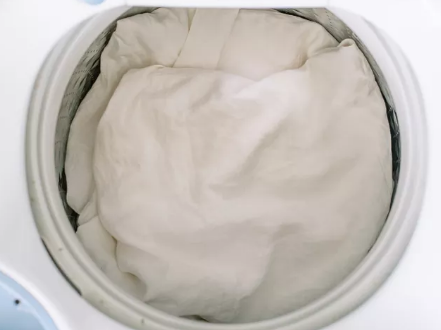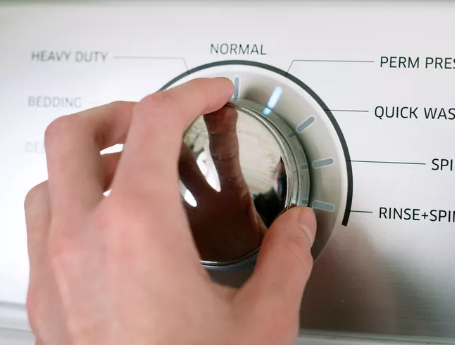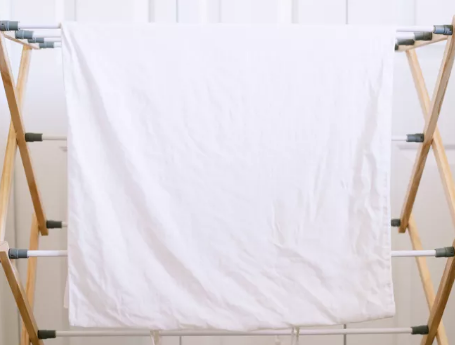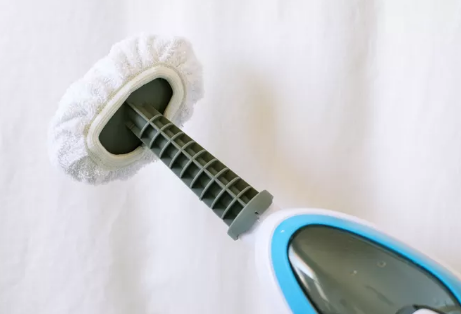Linen is made from flax fibers and is a natural fabric that can be machine washed or hand washed. When trying to figure out how to wash linen sheets or duvet covers, pay close attention to care labels for specific recommendations from the manufacturer. New linen and bedding should be washed before use, and linen for daily use should be washed once a week.
In general, linen can be machine washed safely on a no-iron cycle. The shorter the cycle, the better, which will reduce the wrinkles that may occur in the sheets. Use cold or lukewarm water, as hot water may cause the fabric to shrink. It’s best to use a mild liquid laundry detergent that doesn’t contain harsh ingredients like chlorine or peroxide. Harsh bleach weakens the strength of the fibers and may cause them to turn yellow.
Read on for more details on how to wash and care for linen sheets, duvet covers, and pillowcases.
What You’ll Need
Equipment/Tools
- Washing machine or large bathtub
- Clothes dryers, drying racks, or outdoor clotheslines
- Wool drying balls (optional)
- Regular iron or steam iron (optional)
- Ironing board (optional)
Material
- Mild laundry detergent
- Laundry stain remover (optional)
How to Wash Linen Sheets and Duvet Covers?
1. Sort your clothing

Linen bedding should be sorted by color. It is best to wash linen bedding with other natural fibers such as bamboo and cotton. Never wash dark clothes with white or very light linen.
2. Load the washing machine correctly

Place the bedding in the washing machine in a loosely folded manner. The washing machine should not be overcrowded, otherwise the linen will have too many wrinkles.
3. Select the washing machine cycle and water temperature

Pre-treat the stain on the spot with a small amount of laundry detergent and gently rub it with your fingers.
Use a no-iron cycle to wash linen bedding in warm or cold water. Long wash cycles that rotate at high speed can lead to more wrinkles, and too high water temperatures can lead to shrinkage.
4. Dry the linen bedding

You can hang linen bedding on a drying rack or an outdoor clothesline to air dry. When hanging linen, smooth the folds and edges to reduce wrinkles and help it stay in shape.
If drying in an automatic dryer, choose a timed drying cycle with a medium heat setting. Wool drying balls are added to help speed up drying and soften the fabric. Remove the linen while it is still slightly wet to reduce wrinkles.
Tumble dry in the dryer for 10 minutes, then air dry to make the sheets soft and less wrinkled.
5. Steam to eliminate wrinkles

To remove creases from linen bedding, use a steam ironer or regular iron and bring it to high heat. If using a standard iron, it’s best to iron it when the iron is slightly damp, or use the steam option on the iron to get rid of stubborn wrinkles.
What Is Linen?
Flax is made from natural fibers made from the stems of the flax plant. The thread is woven into a linen fabric that is strong and durable. It is hypoallergenic, breathable, moisture-wicking, moth-proof, and anti-bacterial. It is slightly weaker than cotton when wet and is prone to wear, so it should be washed with care. With use, linen becomes softer and stronger. It wrinkles easily, though.
Treat Stains on Linen Sheets and Duvet Covers
If you have visible stains on your linen bedding, pre-treat the area by following the guidelines for the specific stain type. Oil, blood, or nail polish all require different types of removal treatments.
You can remove most bedding stains by applying a small amount of regular laundry detergent directly to the stained area. Wipe the liquid detergent with your fingers or a soft-bristled brush. Allow the detergent to work for at least 15 minutes before washing the linen bedding.
Before dealing with stains, be sure to test the stain removal product at the inside seam or hem. Apply a small amount of stain remover to the seams and wipe with a cotton swab. Do not use the product if the color is transferred to the swab. Test and use other products instead.
Care and Repair of Linen Sheets and Duvet Covers
Small cracks and tears can be repaired by hand sewing or sewing machine. Linen thread can be matched with most bedding colors. Larger tears may be best left to a sewing professional, or take the item to a local dry cleaner. If your dry cleaners mend clothes, they may also mend sheets.
Ironing of Linen Sheets and Duvet Covers
There are two points of view when it comes to wrinkled linen. Some people like a natural, wrinkled look but never iron it. Others prefer a neater look and ironing bedding after each wash.
If you decide to iron, be sure to iron the linen while it is slightly damp. If the fabric is already dry, spray it gently with distilled water and iron it at a temperature of around 445 degrees Fahrenheit. Quickly thread the iron through the fabric. Do not allow the iron to sit on the fabric, as high heat can damage the fibers. Allow freshly pressed linen to dry completely before use to prevent excessive wrinkling.
Store Linen Sheets and Duvet Covers
Linen bedding should be completely dry before storage to avoid mold and mold growth. Storage should be stored in a temperature-controlled, well-ventilated area and away from direct sunlight to prevent fading and damage to the fibers. Never store linen bedding in a plastic bag, as this will cause moisture.
How Often Should Linen Sheets and Duvet Covers Be Washed
Wash linen sheets, pillowcases, and other items that come into contact with the body, such as duvet covers, for daily use once a week. If you don’t sleep in bed every day, you can extend the time to once every two weeks. New linen sheets feel a little rough on the skin, but frequent washing will help the fibers soften and flatten.
Tips for Washing Linen Sheets and Duvet Covers
- On the first wash, expect more fluff than usual as loose fibers are removed. After multiple washes, the fluff will decrease.
- Consider having three sets of sheets for each bed to help linen bedding last as long as possible. When used in turns (one set in bed, one in the wardrobe, and one in the wash), it gives the bedding fibers time to recover between uses, extending the life of the sheets.
- Use wool drying balls instead of fabric softeners or drying sheets to help keep the linen in its moisture-wicking quality and breathability.
- Fabric softeners leave a residue on the fibers, making the fabric feel tougher and “sleep hotter”. Instead, if you want to add fragrance to the drying process, sprinkle a few drops of essential oil on top of the wool drying balls.